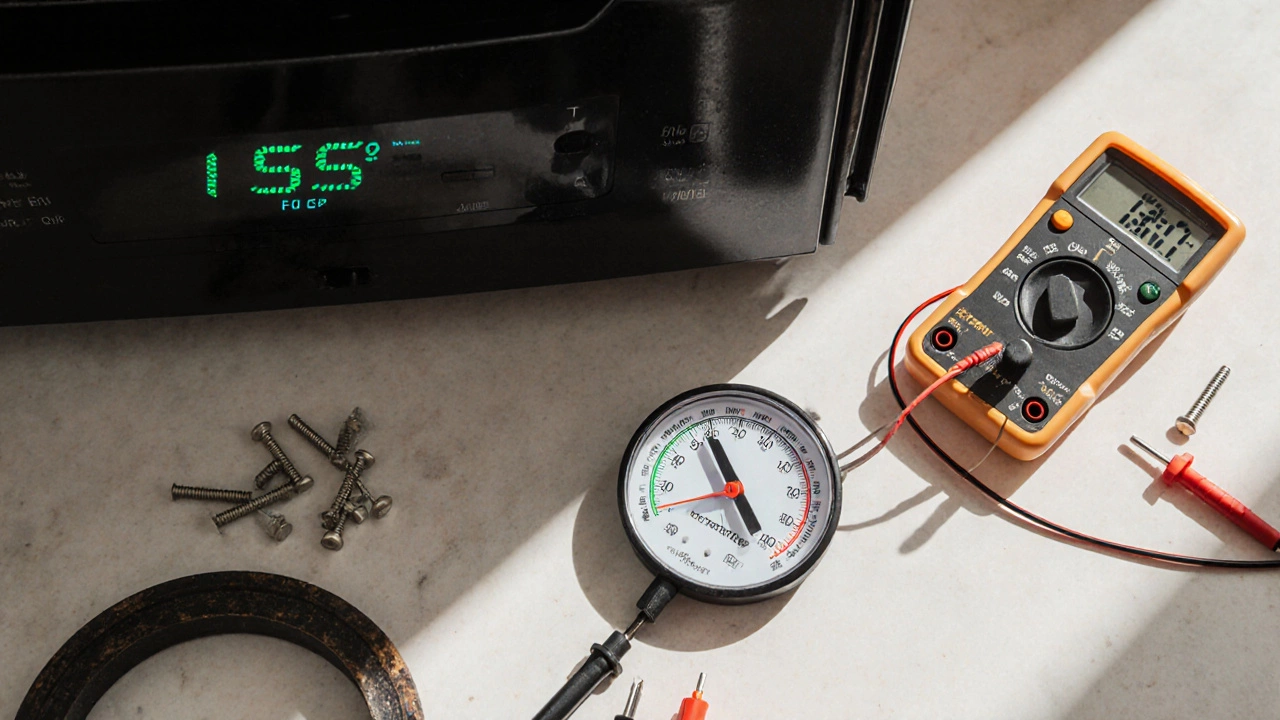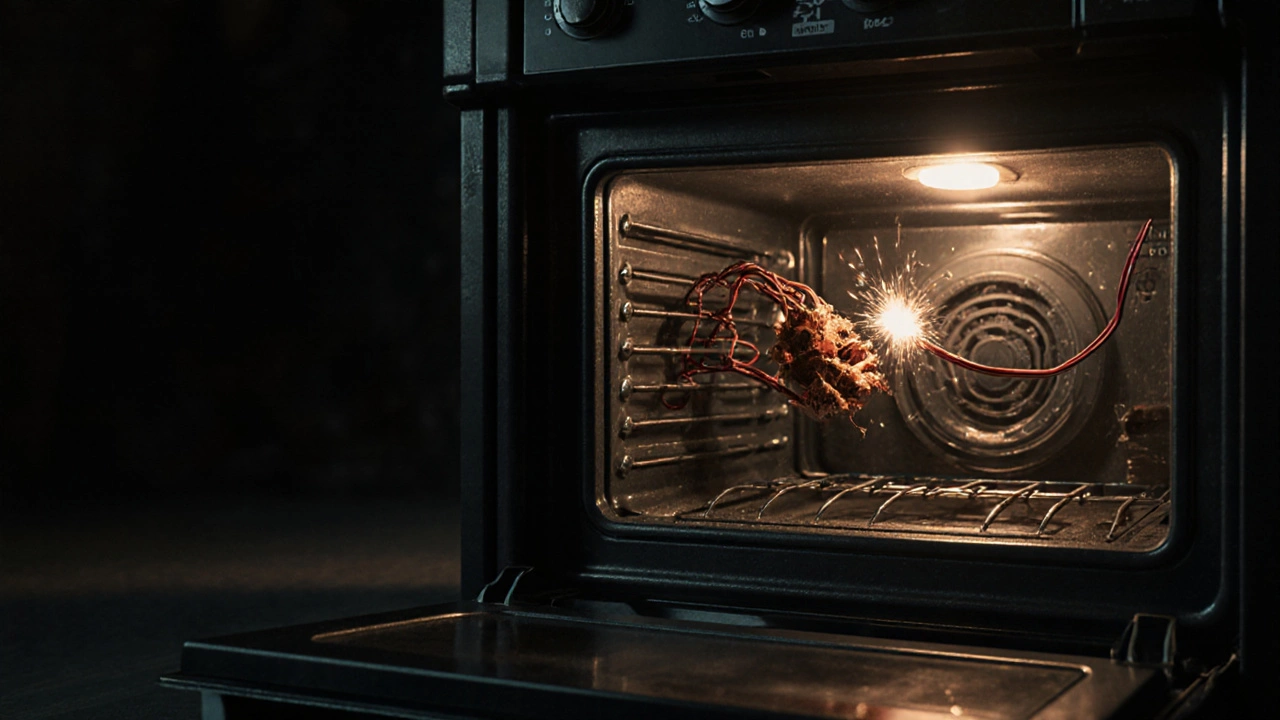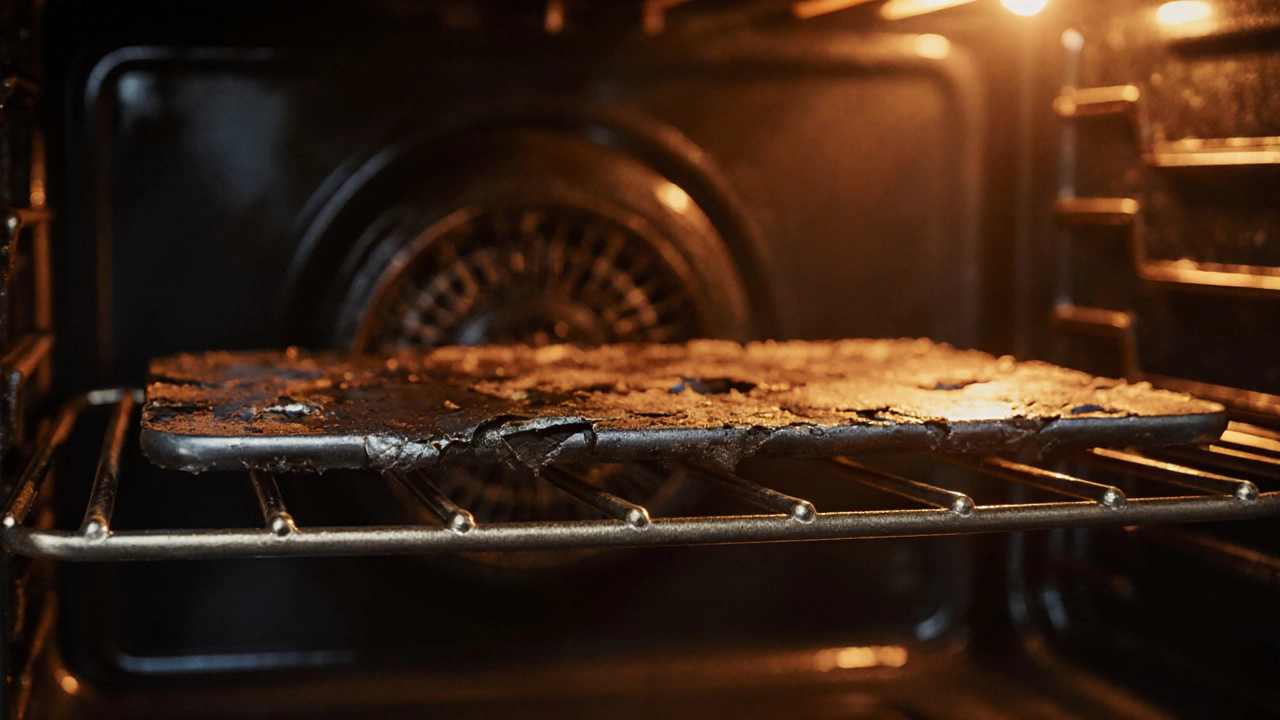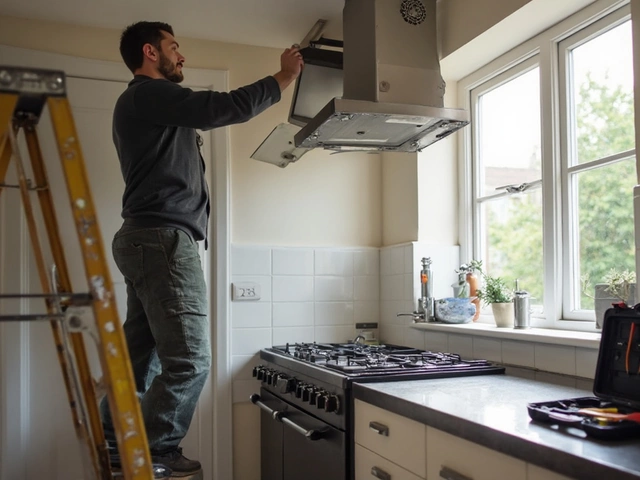Electric Oven Diagnostic Tool
What's happening with your oven?
Before you start
Safety First!
Always unplug the oven before checking internal components. If you're unsure about electrical work, call a professional. Never open the oven while it's in use.
Your oven's model number is critical for parts replacement. Find it on the sticker inside the door frame or on the back panel.
If your electric oven isn’t heating properly, takes forever to preheat, or keeps turning off mid-bake, you’re not alone. These aren’t rare glitches-they’re everyday problems that show up in homes across Auckland and beyond. Most people assume it’s time to replace the whole unit, but 7 out of 10 electric oven failures can be fixed with a simple part swap or adjustment. You don’t need to spend $1,200 on a new oven if you know what to look for.
Heating element failure is the #1 issue
The heating element is the metal coil inside your oven that glows red when it’s working. Over time, it wears out from repeated heating cycles. You’ll know it’s bad if one side of the oven is cold while the other heats up normally, or if you see visible cracks, blisters, or broken sections in the element. A faulty bottom element means your baked goods come out soggy on the bottom. A failed top element means your food won’t brown or broil properly.
Test it yourself: Turn the oven on to 180°C and watch the element. If it doesn’t glow at all-or only glows in patches-it’s dead. You can also use a multimeter to check for continuity. If there’s no electrical flow, replace it. New elements cost between $40 and $80 and usually take under 30 minutes to install. Don’t forget to unplug the oven first. This is the single most common fix I see in my repair work.
Thermostat or temperature sensor malfunction
Your oven thinks it’s hotter or colder than it actually is. That’s the job of the thermostat or temperature sensor. When it fails, your oven might run too hot and burn cookies, or stay too cool and leave your roast undercooked. Many people blame the recipe when the real culprit is a faulty sensor.
Modern ovens use a temperature probe (usually a thin metal rod near the back wall). If it’s bent, corroded, or loose, it sends wrong signals to the control board. You can test this by placing an oven-safe thermometer inside and comparing it to the display. If there’s a difference of more than 15°C, the sensor is likely bad. Replacement sensors cost $30-$60. Replacing it involves removing a screw, unplugging the old one, and plugging in the new one. It’s that simple.
Broken or worn oven door seal
A damaged door gasket might not seem like a big deal, but it’s one of the sneakiest problems. If the seal around your oven door is cracked, brittle, or falling off, heat escapes. That means your oven has to work harder to maintain temperature, which increases energy bills and causes uneven cooking. You might notice the door feels hotter than it should, or the kitchen gets unusually warm during baking.
Test the seal: Close the door on a piece of paper. Try to pull it out. If it slides out easily, the seal is weak. Replace the gasket-it’s a $20 part and takes 15 minutes. Use the right size for your model. A poor seal can also trigger safety shutdowns in newer ovens that detect heat loss.
Control board or electronic control failure
If your oven display is blank, buttons don’t respond, or it won’t turn on at all, the control board might be the issue. This is the brain of the oven. It’s not always broken, though. Sometimes, a power surge or moisture from cleaning causes temporary glitches. Try resetting the oven by turning off the circuit breaker for 5 minutes. If it still doesn’t work after that, the board could be fried.
Control boards cost $150-$300 and are harder to replace than elements or sensors. If you’re not comfortable working with wiring, call a technician. But before you pay for a service call, check if the oven’s clock or timer still works. If it does, the problem might be a blown thermal fuse instead-a $10 part that’s easy to swap.

Thermal fuse blown
This is a safety device that cuts power if the oven overheats. It’s usually located near the heating element or vent. If your oven suddenly stops working with no warning, and the display is dead, the thermal fuse might have blown. It’s not a sign of a broken oven-it’s a sign the oven did its job and protected itself.
Common causes include blocked vents, dirty filters, or a failed thermostat that let the oven run too hot. You can test the fuse with a multimeter. If it shows no continuity, replace it. Always find and fix the root cause first. If you just replace the fuse without fixing what caused it to blow, it’ll blow again in a week.
Igniter problems (in oven with broil function)
Some electric ovens have a broil element that activates with a small igniter, especially in models with convection settings. If the broil function doesn’t work but the bake function does, the igniter could be faulty. You might hear a clicking sound but no glow or heat from the broil element.
Igniters are less common in electric ovens than in gas ones, but they do exist. They’re usually located near the broil element. If it’s cracked or doesn’t glow when activated, replace it. These cost $25-$50 and are easy to swap.
Loose or damaged wiring
Over time, vibrations, heat, and aging can cause wires to loosen or fray. This is especially true near the heating elements or control panel. You might notice intermittent operation-sometimes the oven works, sometimes it doesn’t. Or you might smell burning plastic or see scorch marks inside the back panel.
Never ignore this. Loose wiring is a fire hazard. If you’re comfortable opening the back panel (after unplugging the oven), check for disconnected wires, melted insulation, or corrosion. Tighten any loose connections. Replace damaged wires with the same gauge and rating. If you’re unsure, don’t risk it-call a professional.

Why you should fix it yourself (when you can)
Most of these fixes don’t require special tools. A screwdriver, a multimeter, and 30 minutes of time are all you need. Replacing a heating element or thermostat saves you $100-$200 in service fees. Even if you buy the wrong part the first time, most appliance stores let you return unused parts.
Before you start, find your oven’s model number. It’s usually on a sticker inside the door frame or on the back. Use that number to search for replacement parts. Don’t guess-using the wrong part can damage your oven further.
When to call a professional
You should call a technician if:
- The oven shows error codes you can’t look up
- You smell gas (even in an electric oven-this could mean a nearby gas line issue)
- There’s visible damage to the internal wiring or control board
- You’ve replaced parts and the problem keeps coming back
Also, if your oven is over 15 years old, consider replacement. Older models are less efficient and harder to find parts for. Newer ovens have better safety features and energy ratings that can cut your electricity bill by 20-30%.
Prevent future problems
Keep your oven clean-but don’t use harsh oven cleaners on the interior. They can damage the enamel and sensors. Wipe spills with warm soapy water after the oven cools. Clean the vents and filters every few months. Don’t overload the oven or block airflow. And never ignore strange smells or sounds. A quiet oven is a healthy oven.
Why does my electric oven take so long to preheat?
A slow preheat usually means a weak or failing heating element, a faulty thermostat, or a damaged door seal letting heat escape. Test the element for glow, check the temperature with a separate thermometer, and inspect the door gasket. Replacing any of these parts can restore normal preheat times.
Can a dirty oven cause it to stop working?
Yes. Heavy grease and food buildup can block vents, trap heat, and cause the thermal fuse to blow. It can also coat the temperature sensor, making it read incorrectly. Regular cleaning prevents these issues. Avoid self-clean cycles-they put too much stress on old components.
Is it worth repairing an old electric oven?
If your oven is under 10 years old and the repair cost is less than half the price of a new one, it’s usually worth fixing. For ovens over 15 years old, replacement is often smarter. New models are more energy-efficient, have better safety features, and come with warranties. Repairing an outdated oven can become a money pit.
What does it mean if my oven turns off by itself?
This usually means the thermal fuse blew due to overheating, or the control board shut it down as a safety measure. Check for blocked vents, a dirty filter, or a faulty thermostat. Replace the fuse only after fixing the root cause. If the oven turns off repeatedly, the control board may be failing.
Can I replace the heating element myself?
Yes, most people can. Unplug the oven, remove the back panel or inner panel to access the element, disconnect the wires, unscrew the mounting brackets, and swap in the new one. Make sure you get the exact model match. It takes 20-40 minutes. If you’re unsure about electrical connections, watch a YouTube video for your specific model first.





